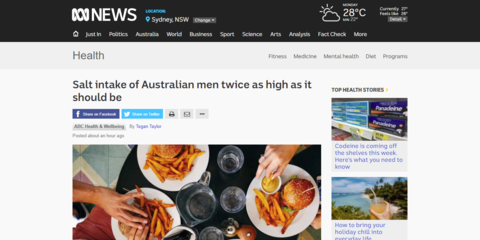
Australian salt intake twice the WHO recommended level
Australian men are ingesting almost twice the recommended maximum daily intake of salt, with women not far behind, according to a systematic review and meta-analysis published online by the Medical Journal of Australia.
Led by Professor Bruce Neal, senior director of the Food Policy Division of the George Institute for Global Health, the authors analysed 31 published studies and one unpublished dataset including a total of 16,836 participants over 26 years (1989–2015). They found that measuring salt intake with methods based on selfreport substantially underestimated consumption.
The gold standard for measurement of salt intake — 24-hour urine collections — provided the “best estimate”, the authors wrote.
“After adjusting for non-urinary salt excretion, the best estimate of salt intake in Australia is 9.6 g/day,” they wrote. “The mean weighted intake was 10.1 g/day (95% CI, 9.68–10.5 g/day) for men and 7.34 g/day (95% CI, 6.98–7.70 g/day) for women.”
The World Health Organization recommends a maximum salt intake of 5 g/day, and all WHO member states, including Australia, have agreed to reducing the mean population salt intake by 30% by 2025.
“Strong and consistent evidence indicates that a high dietary salt intake increases blood pressure, which in turn increases the risk of cardiovascular disease,” they wrote. “Despite a steady improvement in mortality rates over the past three decades, cardiovascular disease remains the leading cause of death in Australia… reducing population salt intake is projected to be one of the most cost-effective strategies for reducing rates of premature death and disability attributable to high blood pressure and vascular disease.”
The problem, the authors wrote, is that, despite a number of programs for reducing salt intake being implemented in Australia, “there has been no robust assessment of national intake levels that would permit the success or failure of these programs to be quantified”.
“Our results also highlight the need for systematic, standardised and repeated assessments of a national sample of the population in order to determine whether salt reduction programs are achieving the target of a 30% reduction in intake by 2025,” the authors concluded.







